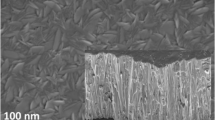Abstract
It is well known that the diffusion of hydrogen atoms through the intrinsic defects of a crystal lattice has characteristics different from those of bulk diffusion and, at certain parameters for some polycrystalline metals, ensures the determining contribution to the transfer of hydrogen atoms through the material. Grain boundaries (and dislocations) are the most important and shortest paths, the diffusion through which is much faster than bulk diffusion through a crystal lattice. It is particularly important to take into account this diffusion in materials with grains having sizes of about several nanometers. The possibility of using the method of the plasma-stimulated penetrability of hydrogen to analyze phase transitions at the grain boundaries is demonstrated on the example of polycrystalline niobium foils. In contrast to the existing methods, this method proposed for studying grain-boundary diffusion and phase transitions is simple and ensures control over the surface. The temperature characteristics of the diffusion of hydrogen atoms through niobium grain boundaries have been measured.
Similar content being viewed by others
References
B. B. Straumal, Phase Transitions on Grain Boundaries (Nauka, Moscow, 2003) [in Russian].
B. B. Straumal, B. S. Bokshtein, A. B. Straumal, et al., Pis’ma Zh. Eksp. Teor. Fiz. 88, 615 (2008) [JETP Lett. 88, 537 (2008)].
I. Kaur and W. Gust, Fundamentals of Grain and Interphase Boundary Diffusion (Zeigler, Stuttgart, 1989).
V. B. Vykhodets, E. V. Vykhodets, B. A. Gizhevskii, et al., Pis’ma Zh. Eksp. Teor. Fiz. 87, 124 (2008) [JETP Lett. 87, 115 (2008)].
G. Counsell, P. Coad, C. Grisola, et al., Plasma Phys. Control. Fusion 48, B189 (2006).
A. A. Skovoroda, V. S. Svishchov, A. V. Spitsyn, et al., J. Nucl. Mat. 306, 232 (2002).
A. A. Pisarev and V. M. Smirnov, Atom. Energiya 61, 178 (1986).
A. I. Livshitz and M. E. Notkin, Zh. Tekh. Fiz. 7, 605 (1981).
Y. Hatano, A. Livshits, Y. Nakamura, et al., Fusion Eng. Design 81, 771 (2006).
A. Spitsyn, A. Pisarev, A. Skovoroda, et al., J. Nucl. Mater. 363–365, 833 (2007).
B. Roux, H. Jaffrezic, A. Chevarier, et al., Phys. Rev. B 52, 4162 (1995).
I. Isagawa, J. Appl. Phys. 51, 4460 (1980).
C. Antoine, B. Bonin, H. Safa, et al., J. Appl. Phys. 81, 1677 (1997).
X. R. Qian and Y. T. Chou, Philosoph. Magazine A 45, 1075 (1982).
Y. T. Chou, B. C. Cai, A. D. Romig, et al., Philosoph. Magazine A 47, 363 (1983).
Hydrogen in Metals, Ed. by G. Alfeld and J. Völkl (Springer, Berlin, Heidelberg, 1978).
V. A. Somenkov and S. Sh. Shil’shtein, “Phase Trans-formations of Hydrogen in Metals,” Preprint IAE im. Kurchatova (Moscow, 1978).
Author information
Authors and Affiliations
Corresponding author
Additional information
Original Russian Text © A.A. Skovoroda, A.V. Spitsyn, 2009, published in Pis’ma v Zhurnal Éksperimental’noĭ i Teoreticheskoĭ Fiziki, 2009, Vol. 89, No. 10, pp. 589–592.
Rights and permissions
About this article
Cite this article
Skovoroda, A.A., Spitsyn, A.V. Plasma-stimulated penetrability of hydrogen as a tool for studying phase transitions at grain boundaries. Jetp Lett. 89, 496–499 (2009). https://doi.org/10.1134/S0021364009100051
Received:
Accepted:
Published:
Issue Date:
DOI: https://doi.org/10.1134/S0021364009100051



